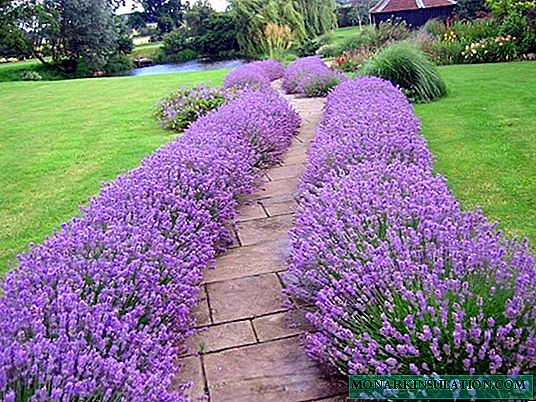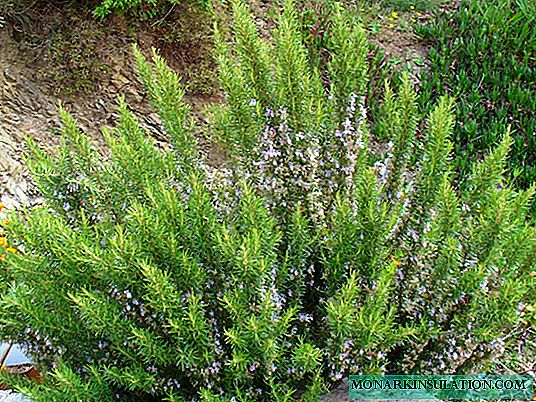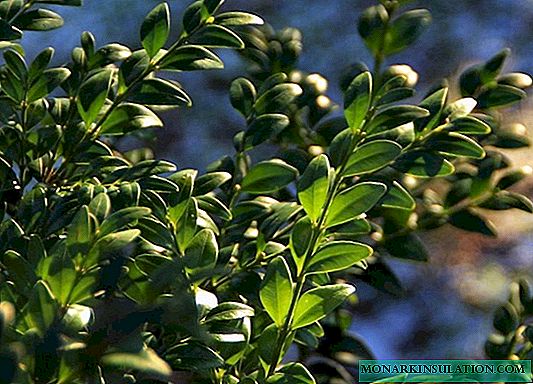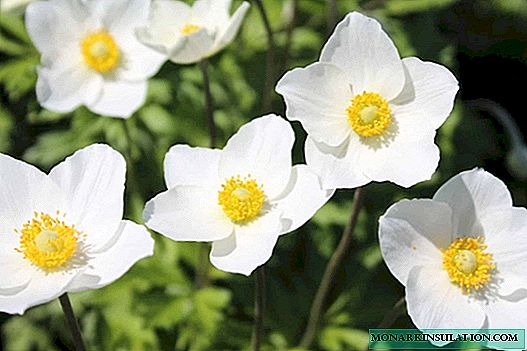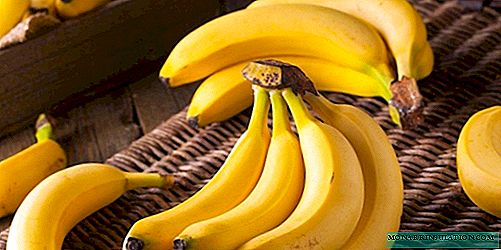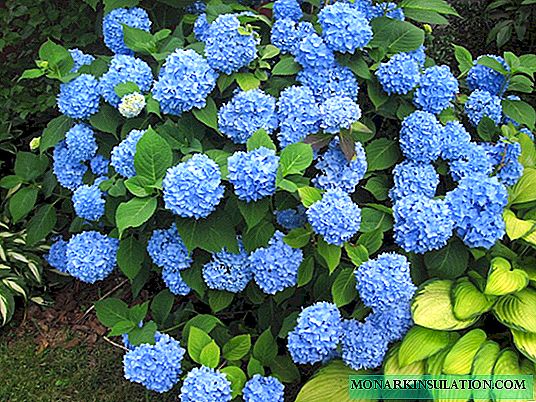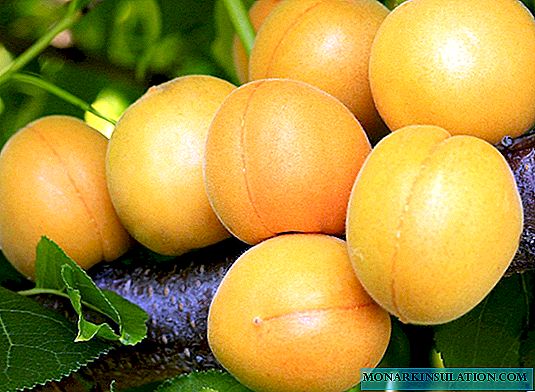 Cordylina (Cordylina) - a perennial plant from the Agave family. It is found in the tropical and subtropical forests of Brazil, New Zealand, Australia. Under natural conditions, grows a powerful spreading tree up to 16 m high. Indoor cordilina grows slowly, increasing growth by 0.15 m per year.
Cordylina (Cordylina) - a perennial plant from the Agave family. It is found in the tropical and subtropical forests of Brazil, New Zealand, Australia. Under natural conditions, grows a powerful spreading tree up to 16 m high. Indoor cordilina grows slowly, increasing growth by 0.15 m per year.
Usually at home the tree reaches 35 - 90 cm, but species are known that grow at home up to 1.5 m. A plant, well leafy at a young age, quickly loses its leaves over the years. The trunk thickens, and the bush becomes like a tall palm tree with a rosette of leaves at the top.
Home cordilina rarely blooms. Every 3 years it produces long panicle inflorescences with small star-shaped flowers. Differs in coloring and a diverse look of leaves. They can be not only green, but also scarlet, purple, burgundy with contrasting stripes along the leaf.
| Cordilina is slowly growing, 15-20 cm per year. | |
| Only adult plants bloom. | |
| The plant is easy to grow. | |
| Perennial. |
How to distinguish cordilina and dracaena

Cordilina is often mistaken for a plant similar to it - dracaena. The visible difference is in the leaves. Cordilina leaves have petioles, a vein runs in the center of the leaves, the rest diverge from it. The leaves of the dracaena have no petioles; veins on dracaena leaves are located parallel to each other.
The root of the dracaena is straight, on the cut - orange-yellow. At the cordilina it is covered with knots and cones (the name came from here, in Greek cordylle - "cone, knot"), on the cut - white. The dracaena fruit contains 1 seed, the cordilina fruit - up to 20.
Cordilina care at home (briefly)
At home, not all species of cordilina growing in the wild can be grown: lack of light, space and dryness of home air affect it. Cordilina at home grows well if you create optimal conditions for her:
| Temperature | Permanent (at any time of the year from + 18 - 23 ° C); withstands up to + 13 ° C, if not watered in winter. |
| Air humidity | High; in winter keep away from batteries, spray from 2 times in 7 days, put in a pan with wet expanded clay. |
| Lighting | Cordilina green leaves grows when shaded, having bright leaves prefers diffused bright lighting. |
| Watering | In winter - once a week, the rest of the time - from 2 times a week; the soil should dry to a depth of 3 cm; broadleaf species in summer require more moisture. |
| Priming | A mixture of peat, garden soil, sand (perlite) (1: 3: 1); good drainage required. |
| Fertilizer and fertilizer | In summer, during growth - once every 14 days (with liquid fertilizer after watering). |
| Transfer | Mature bushes - after 3 years, young - every year (in a pot, the diameter of which is 20 mm larger than the previous one); held in the spring, when the roots of the plant cover the entire earthen lump. |
| Breeding | Dividing the bush, stem or apical cuttings, seeds. |
The plant is unpretentious, but there are features of growing cordilina. In order for the thin trunk to withstand the heaviness of the foliage, it is supported by a support - a tube covered with coconut fiber, or bamboo sticks. A bush with a thick trunk grows without support. The tree should be protected from drafts and a sharp temperature drop.
To stimulate the appearance of new leaves, periodically cut off weak shoots. The leaves are regularly wiped with a soft damp cloth to moisturize and clean their surface.
Care for cordilina at home. In detail
Home cordilina unpretentious, she adapts to the conditions created by her in the apartment. Well, if they are optimal, then when growing a “false palm” many difficulties can be avoided.
Cordilina planting
Planting cordilina is an important procedure on which the vegetation of a plant depends. Cordilina loves slightly acidic soil (pH around 6.5). Soil can be prepared independently by adding one share of sand (perlite) and peat to 3 parts of garden soil. You can buy a universal flower soil mixture.
The pot for an adult plant is selected high: the lateral shoots of cordilin give little, the root system grows deeper. As a drainage, a thick layer of expanded clay or broken brick is placed at its bottom. Work with the bush carefully so as not to damage the roots. Try not to deepen the root neck.
Often several bushes are planted nearby: so a weakly branched plant looks more attractive. Large varieties are planted separately. In an apartment, cordilina grows on a wide stable stand or on a windowsill.
Flowering cordilina
 Flowering cordilina at home is rare. Often cordilina is intentionally grown as a decorative foliage plant.
Flowering cordilina at home is rare. Often cordilina is intentionally grown as a decorative foliage plant.
Only adult bushes bloom, forming small stellate flowers of a cream or purple hue on long peduncles. Many species need a cool wintering to bloom.
Temperature mode
In order for the cordilin flower to feel comfortable at home, it is recommended to observe the temperature regime.
It is necessary to constantly maintain the temperature from + 18 - 23 ° C in the room. If the bush is not watered in winter, it can withstand up to + 13 ° C. Cordilina is protected from draft and a sharp temperature drop.
Spraying
Spraying - a procedure useful for a tropical plant. With its help, cordilina gets the extra moisture it needs. The humidity level should be up to 80%.
In the heat and during the heating season, the leaves of the tree are sprayed with standing tepid water once a day. This is best done in the evenings or in cloudy weather. After the procedure, shading is necessary so that the sun does not burn the leaves.
Lighting
In order for cordiline to develop well, home care involves receiving enough light. Species with green leaves grow normally with slight shading, species with leaves of other colors prefer diffuse bright lighting, so it is best to place cordilina on windows facing east, northeast and northwest.
If the windows face south or west, the plant is set aside from the window and shaded by curtains. If there is not enough natural light, fluorescent lamps are installed (some growers advise to definitely include phytolamps for variegated species).
Watering
 Cordilina loves moderate watering. Excess moisture leads to rotting of the roots. It is also impossible to allow the soil in the pot to completely dry out. Cordilina is watered if the topsoil has dried to a depth of 3 cm. In winter, this is usually done 1 time in 7 days, at other times - 2 times in 7 days.
Cordilina loves moderate watering. Excess moisture leads to rotting of the roots. It is also impossible to allow the soil in the pot to completely dry out. Cordilina is watered if the topsoil has dried to a depth of 3 cm. In winter, this is usually done 1 time in 7 days, at other times - 2 times in 7 days.
It should be borne in mind that broad-leaved species in summer need more moisture than narrow-leaved ones. Watered with warm, settled water; mulch with coconut substrate or crushed bark.
Periodically, a warm shower is carried out to refresh the plant and wash dust off the leaves.
Cordilina pot
The first time the tree is planted in a small container, as it grows, the diameter of the container is increased by 1.5 cm compared to the previous one. The plant forms few side shoots. Therefore, the pot for cordilina needs a vertical high, so that nothing would impede the movement of the root down.
It is not worth taking a pot too large for a small bush: the roots will not be able to braid the earth in it, their rot will begin. The bottom must have drainage holes.
Cordilina primer
Cordilin at home can grow well in a universal palm mix that you can buy. You can prepare the soil for cordilina yourself, taking 1 part of peat and sand, 3 parts of garden soil. When choosing soil, it should be borne in mind that the plant loves the soil slightly acidic or neutral (pH in the range of 6 - 6, 5), loose and fertile. Sometimes the substrate is improved with crushed birch charcoal (protects from rot) or brick crumb (will increase friability).
Shredded moss and some garden soil are added to the universal soil. In order to protect cordilina from diseases and pests, the soil is roasted or frozen. A claydite layer is placed at the bottom of the pot to avoid stagnation of water and soil compaction.
Fertilizer and fertilizer
Fertilizing and fertilizing are important for the harmonious development of the plant. They make up for the nutrient deficiency that cordilina experiences during intensive growth. This usually happens from late March to early September.
Fertilizing is carried out with complex mineral fertilizers for domestic plants - once every 14 days (liquid fertilizer is diluted with warm, settled water, used after watering). It is possible to carry out foliar top dressing in the evening or in cloudy weather. From mid-September to late March, cordilina rests, at this time it is impossible to stimulate its growth, so as not to deplete the plant.
Cordilina transplant
 Cordilina transplant is carried out in the spring. Young trees are replanted every year, mature - after 3 years, when the roots cover the entire earthen lump. If cordilina does not cause anxiety and develops normally, it is better not to disturb it: any transplant is stress for the tree. Sometimes a transplant is done more often (if the bush has grown strongly, and its roots protrude from the drainage holes or, on the contrary, growth has stopped; the roots are rotting; insects have settled in the ground).
Cordilina transplant is carried out in the spring. Young trees are replanted every year, mature - after 3 years, when the roots cover the entire earthen lump. If cordilina does not cause anxiety and develops normally, it is better not to disturb it: any transplant is stress for the tree. Sometimes a transplant is done more often (if the bush has grown strongly, and its roots protrude from the drainage holes or, on the contrary, growth has stopped; the roots are rotting; insects have settled in the ground).
An adult plant is transshipped into a new container, whose diameter is 1.5 cm larger than the old one, trying not to damage the roots. You can update the topsoil once a year. After the purchase, a tree is observed for several days: are there any diseases, insects in the soil.
If the tree is affected, use an insecticide and transplant into a new pot. After transplantation, the cordilina is kept in the shade for several days so that it adapts to new conditions. After 2 weeks, you can feed.
Pruning
Pruning of weak shoots is needed for cordilina rejuvenation and the formation of a dense leafy crown, because it causes the growth of lateral buds. The top of the bush is cut with a sharp clean knife (it is important that this fragment is at least 6 cm, has several leaves and is no longer green, but light brown, i.e. a little lignified).
The cut points are sprinkled with charcoal powder. After 2 weeks, young shoots will appear on the slices. The top is rooted in water or a moist mixture of sand and peat. After the appearance of the roots, it is planted in a small pot.
Rest period
The plant dormancy period falls at the end of autumn - the beginning of spring. At this time, cordilina stops the growing season and is gaining strength. The tree is rearranged in a cool room. In order not to freeze its roots, the pot is placed on a thick piece of wood or polystyrene.
At a temperature of + 15 ° C, watering and spraying are reduced.
For variegated species, additional LED or fluorescent lamps are installed. During rest, cordilina is not fed.
Reproduction of cordilina
Reproduction of cordilina is possible in several ways:
Rhizome propagation
Take out a bush from a pot. The rhizome is washed. The fragment is separated with a sharp clean knife. The cut points are sprinkled with coal powder, dried and planted in a moist mixture for rooting (peat, sand, sheet soil, taken in equal doses). Cover with polyethylene. The sapling is kept at + 25 ° C, watered, ventilated, sprayed. A month later, when the roots grow, transplanted into a larger pot.
Propagation of cordilina by cuttings
Propagation by cuttings: take from the top or the stem of a lignified shank, having 1 to 4 nodes (about 12 cm). Planted in the ground for rooting (apical stalk can be rooted in water by adding a stimulator of root formation). Water and cover with a bag. Contain at + 27 ° C. Take care of the seedling. After about 30 days, when the roots appear, it is transplanted into a pot.
Growing cordilina from seeds
Seeds for sowing need fresh (they quickly lose their germination). They are soaked in "Epin" or "Zircon", sown in the spring in a mixture of garden soil and sand (1: 1). Seeds germinate unevenly, germinate for a long time. Germinated in mini-greenhouses at + 28 ° C.
All methods are simple, but the most popular are the first 2. Seeds in home floriculture cordilina rarely reproduces, although a tree grown from a seed is fully adapted to room conditions.
Diseases and Pests
Cordilina is an unpretentious plant. If you initially create the right conditions, diseases and pests will bypass it, otherwise the bush will suffer in silence, pointing out external signs of problems:
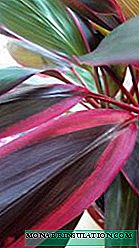 stalk of cordilina rots - excess moisture (root top);
stalk of cordilina rots - excess moisture (root top);- light and dry spots on the leaves - a lot of light (shade);
- brown spots on cordillin leaves - lack of moisture (pour plenty of water, cover with a film and put it in the shade for several hours);
- leaves become soft, cordilina leaves darken, leaves curl - the plant is cold (rearrange in a warm place);
- the tips and edges of the cordilina leaves dry, the lower leaves fall off - very dry air in the room (spray; if the lower leaves on the mature cordil fall off - a normal physiological phenomenon, remove the fallen leaves in time);
- leaf color fades - lack of lighting (rearrange in a bright place);
- cordilina grows poorly - lack of nutrients (feed);
- in cordilina leaves rot and fall - excess moisture and hypothermia (rearrange in a warm place, monitor watering);
- leaves turn yellow and die - dry air, nutritional deficiencies (spray, feed);
- leaves wither, but do not dry, shoots lose elasticity - fungal disease (fungicides are used; if the roots are rotten, root the apex).
In a room with dry, hot air, cordilin is affected by a scab, a mealybug, aphids, thrips, and spider mites. Pests are particularly attracted by the tender leaves of young plants. It is difficult to fight insects, it is better not to allow their appearance.
Types of cordilina home with photos and names
Home cordilina is represented by 5 species. All of them are popular.
Cordilina apical (shrubby) / Cordyline terminalis (fruticosa)

The most popular type of home cordilina. A thin trunk (diameter up to 1.5 cm) is branched. The width of the leaf is 10 cm, the length is 50 cm. The length of the grooved petiole is up to 0, 15 m. Green lanceolate leaves with stripes or rims of different colors (raspberry, light pink, red). Inflorescence is a loose panicle.
Cordilina undivided (Cordyline indivisa)

The most unpretentious kind of home cordilina. The leaves are long and wide. Green with a red or yellow stripe in the center. Sometimes they have a thin strip along the edge.
Cordilina south (Cordyline australis)

Long green leaves are narrow. At the top are collected in a bunch. A light green stripe runs along the sheet plate. Paniculate long inflorescences are formed by white fragrant flowers. It looks like a palm tree.
Cordilina straight (Cordyline stricta)

High straight trunk. Leaves narrow long lanceolate or linear in shape. Painted green or purple. Sheet width - 3 cm, length - up to 60 cm.
Cordilina Banks (Cordyline banksii)

The trunk is straight thin. Elongated lanceolate leaves with long petioles are bundled. The leaves are green, the underside is gray-green. Loves the cool.
Cordilina, the owner of bright juicy foliage, adapted well to home conditions. Slow growth, endurance and unpretentiousness make it an ideal plant for the home. The plant pleases with elegant green foliage all year round, if given due attention to it.
Now reading:
- Dracaena - home care, reproduction, photo
- Chlorophytum - care and reproduction at home, photo species
- Alocasia home. Cultivation and care
- Washingtonia
- Aglaonema - home care, photo

 stalk of cordilina rots - excess moisture (root top);
stalk of cordilina rots - excess moisture (root top);